|
Nearly all amateur boat builders of small boats start off by buying a
readymade set of plans before, if ever, they get the urge to design their
own. It is the best way to
get the experience without that it has to cost you an arm and a leg.
But even if they stick to buying plans, at one time
or another, they just will have to make at least a full-sized Body-view
drawing.
Accuracy in drawing of Side Panel Planks
without Extensive Software
In art supply stores, they sell at a reasonable price
24"x36" easel pads with a very accurate one-inch grid of thin,
light-blue lines. Drawing on
this kind of paper is easy and enhances the accuracy.
If you stay an amateur, a pad will last you a lifetime.
In the Body view of a constant-flared hull, the
parallel running station lines of the side panels are always skewed.
Unless the chine line runs parallel to a straight sheer line in the
Body view, this line becomes a concave curve on the expanded side panels.
That curve is plotted onto the material by transferring the
measurements from the station lines from the Body view and connecting the
plotted points by a line that is drawn along a flexible batten.
Next to transferring these measurements with a divider compass,
working with a tick strip is far more accurate than measuring the lines.
After having drawn the Body view to scale in
the conventional way as shown below in figure 6-1A, I make a
full-sized, second drawing, see figure 6-1B.
In this drawing, the side panel is tilted by the amount of the
flare angle of 22.62º.
For a constant-flared hull the station lines in figure B run parallel to
the vertical grid lines of the easel pad.
It gives an easy double-check of the correctness of the dimensions
transfer. Note that the
26" sheer line has become the horizontal base line for this second
drawing.
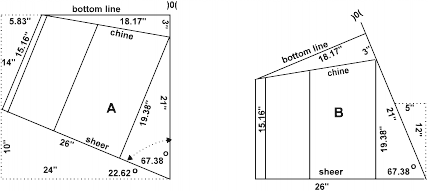
Fig. 6 - 1
For accurate plotting of the width of the expanded
side panels,
Figure B is made full size.
When the tilted drawing 6-1B is constructed
full size on the special one-inch-grid-easel-pad paper with a sharp
pencil, the measurements of the plotted width of the side panels on the
station lines are accurate to two decimal figures.
Expanded Side Panels
In a hard-chined hull design, making the expanded
side panels is not difficult.
The sheer line is a straight line.
It is possible, and very easy to design a hull with the chine line
parallel to the sheer line.
The (half)-Body view looks then as is shown in figure 6-2A.
The chine line and the sheer line are straight and run
parallel in the drawing of the expanded panel.

Fig. 6 - 2
Chine lines
In the (half)-Body view of figure 6-2B
the chine line diverges from the sheer line.
In figure 6-2C the line converges into the direction of the
sheer line. In nearly all
designs figure 6-2B is the hull shape fore of Beam for a higher
bow, while figure 6-2C represents a sweeping stern end aft of Beam.
In the Profile view the chine lines of figures 6-2B and 2C are
concave curved lines as is shown in figure 6-3.

Fig. 6 - 3
Expanded side panel
When the cross frames, the stem, and the transom are
properly aligned on a building jig, transferring the dimensions of the
side panels becomes easy. The
distances between the station lines on an expanded panel are not constant
but increase from Beam toward fore and aft.
For accurate measurement, place an inwale in the frame notches. Mark the exact position of the station lines on the inwale.
Along the inwale, measure the distances of the station lines with a
tape measure, or a tick strip made from Bristol board.
Transfer the distances of the station lines to the straight sheer
line edge of the material for the side panels.
Construct the vertical station lines on the side panel
material. Plot the width of
the panel at each station location.
Clamp a flexible batten along the plotted points.
Draw the chine line and cut the panel at the chine line at flare
angle.
This is the way to do it with the stitch-and-glue,
or the tack and tape methods.
When the set of plans shows an inside chine batten,
it becomes even easier. Clamp
the panels on the protruding shoulders of the cross frames. Draw the chine line along the chine slat on the inside of the
side panel.
No matter how it is done, this tip makes things
easier: It is a good rule to
measure twice and to cut once.
My method is to measure three times and to cut twice.
When there is a curved line to be cut, I make an
extra cut about ¼" to ½" parallel to the to-be-drawn
curve and remove the excess.
It becomes a lot easier to clamp the flexible batten along the plotted
points of the chine line, which can now be done with the handy binder
clamps. The second advantage is that I can start cutting at the
middle of a convex curve and prevent the saw from tearing into the line by
the grain of the wood by cutting toward the ends.
For a concave line to prevent being drawn into the
curved line by the grain of the wood, always start at the ends and work
your way slowly toward the middle.
Multi Chine
In 1941, W. W. Norton & Company, New York, London
published the book BOATBUILDING, a Complete Handbook of Wooden Boat
Construction. Written by
Howard I. Chapelle, it still is considered the BIBLE for boat-building
amateurs.
On page 44, he wrote, and I quote ad verbatim:
“MULTI CHINE TYPES.
Hulls having more than one chine on each side are sometimes designed for
amateur construction. Those boats most commonly have two chine lines on each side
and are planked fore and aft.
It is doubtful if there is any particular advantage to such a hull shape,
but some designers and builders prefer it to the orthodox single chine. The planking has to be spaced and fitted as in a round bottom
boat, though it is easier to get the plank in place. The chines are generally backed with a batten, beveled to fit
the angles of the frames and plank.
A better construction, though harder to do, is to lap the edges of
the planks at these chines and omit the chine battens.
This is the sailing dory construction; by multiplying the number of
chines, a round-bottom hull results.”
From this quotation, I come to the conclusion that
Howard I. Chapelle did not think much of multi-chine construction.
Actually, multi-chine construction comes down to
reducing the cockpit space, the width of the flat bottom, and hence the
flotation capacity of the hull if you start off at the same initial
sheer line and flare angle of both hulls as is seen in figures 6-4A and B.
The multi chine hull shown in figure B becomes (sometimes
unpleasantly) nimble. At the
same time, it requires extra work. The extra seam increases the chance of leakage.
Actually, it goes directly against the KISS formula:
Keep It Simple, Sailor.
On the other hand, when the initial side panel flare
ratio and consequently the sheer lines are changed, roomy hulls with
attractive line result as shown in figure 6-5B.
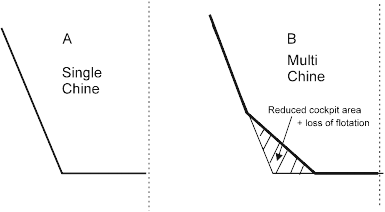
Fig. 6 - 4
Single chine compared with multi chine
What is a lumpy, ugly design of a slow hull in
single chine form in figure 6-5A, imho, becomes a roomy, fast boat with
beautiful lines when it is changed to a double chined design of figure
6-5B.
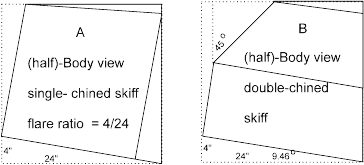
Fig. 6 - 5
Double chine versus single chine
TUMBLE HOME
Instead of
dividing the side panels into two, or more planks, in tumble home
construction, an extra plank is placed on top of the sheer.
The plank on top of the sheer is placed at an inward, obtuse angle
with the side panel. The
inward tilt could be called a negative flare angle.
The width of the plank often diminishes fore and aft at the ends to
reduce windage.
An angled
steel beam is much stronger than just an ordinary beam.
The same effect is obtained by placing the tumbled-home plank under
an obtuse angle inward on top of the side panel.
Many Dutch boats are built that way.
Besides that it makes a very strong hull, it provides an ideal spot
to attach the leeboards.
Angle
There are no fixed rules for the (negative) flare angle
of the tumbled-home plank.
The lesser the obtuse angle between the two boards that form the side
panel, the stronger the hull becomes.
However, the angle is never bigger than the flare angle of the side
plank onto which this additional plank is placed.
This leaves a lot of choices to the designer.
Figure 6-6 shows a view of these choices. In the choice of this angle, the practicality of attaching
the guardrails must be considered.

Fig. 6 - 6
Choices for tumbled-home angle
Guardrails
Flare Angle of
the Tumbled-Home Panel

Bevel Angle of
the two Side Panel Planks

Actual Tumbled-Home Plank in Body View
Figure 6-9 shows the complete Body view of the hull,
albeit without the guardrails.

Fig. 6 - 9
The completed Body view
Tumbled-Home Planks
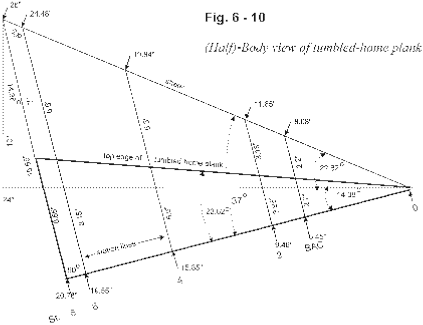
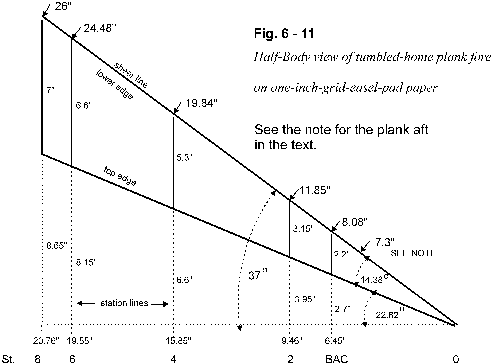
Template for the Expanded Tumbled-Home
Planks
CONCLUSION
For a novice amateur,
it is still possible to solve lofting and construction problems with a
high degree of accuracy with simple means, and a bit of ingenuity
without the need of comprehensive, expensive CAD software.
Barend |